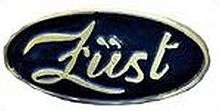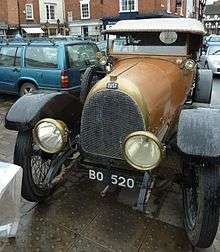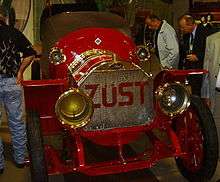Zust
Zust (originally Züst) was an Italian car manufacturing company operating from 1905 to 1917.


The company was founded by engineer Roberto Züst, an Italian industrialist of Swiss origin,[1] who owned a precision tool manufacturing plant at Intra, near Lago Maggiore (formerly the Guller & Croff iron foundry[2]). Züst experimented with prototypes of cars from around 1900 on and in Milan in 1905, he founded the Zust company for manufacturing cars and commercial vehicles.[2] His first models were huge and expensive machines propelled by four-cylinder engines from 7432 cc (454cuin) to 11308 cc (690cuin). These were joined by a slightly smaller 5-litre (305cuin) model in 1908.[2] A Zust 28/45 HP participated in the 1908 New York to Paris Race[3] and finished third.[4] Giustino Cattaneo (later of Isotta Fraschini) worked for him.

In 1906 Züst decided to also make smaller cars, so with his five sons he founded a new company known as Brixia-Zust in the city of Brescia. (Zust and Brixia-Zust are often confused). Due to financial problems, Brixia-Zust closed down in 1912; the Milan factory was sold and production of Zust cars concentrated in Brescia, where production continued until 1914. The last new models, the 15/25 HP or 2S 365 (2592 cc/158cuin) and the 25/35 or S305 (4712 cc/288cuin), appeared in 1913.
On October 1, 1917, the company was taken over by Officine Meccaniche of Milan, who continued to make the S305 until 1923 under their own name.
Brixia-Zust
Brixia-Zust (originally Brixia-Züst) was an Italian car manufacturer also founded by engineer Roberto Züst, owner of Zust of Milan, and his sons. The company was situated in Brescia, Northern Italy; Brixia is the antique Latin for Brescia. The company made racing cars that participated in Targa Florio, an open road race in Sicily.
The most interesting model was the 10 hp in 1909, propelled by a three-cylinder 1495 cc engine. Car production ended—due to financial difficulties—in 1912. In 1918, after Officine Meccaniche took over the Zust company, the Brescia facilities were used.
References
- Charles Lam Markmann; Mark Sherwin (2014). The Book of Sports Cars - (United States and Italy. Edizioni Savine. ISBN 9788896365465. Retrieved 27 March 2020.
- Cavaliere, David (11 May 2016). "Part 13 – Brixia-Zust and Zust". The Italian Tribune. Retrieved 27 March 2020.
- "OCEAN MOTOR RACE PLAN OF ITALIANS; Manufacturers Enthusiastic Over Work of Zust Car in Paris Auto Race. BOATS TO CROSS ATLANTIC Race Is Intended as an Exhaustive Test of the Italian Type of Motor Engine". The New York Times. The New York Times Archives. 22 February 1908. Retrieved 27 March 2020.
- "Today in History: The Great New York to Paris Automobile Race Beings". Onondaga Historical Association. 12 February 2017. Retrieved 27 March 2020.
External links
| Wikimedia Commons has media related to Züst vehicles. |
- http://www.targaflorio.info/zust.htm (in Italian)
- For Brixia-Zust: